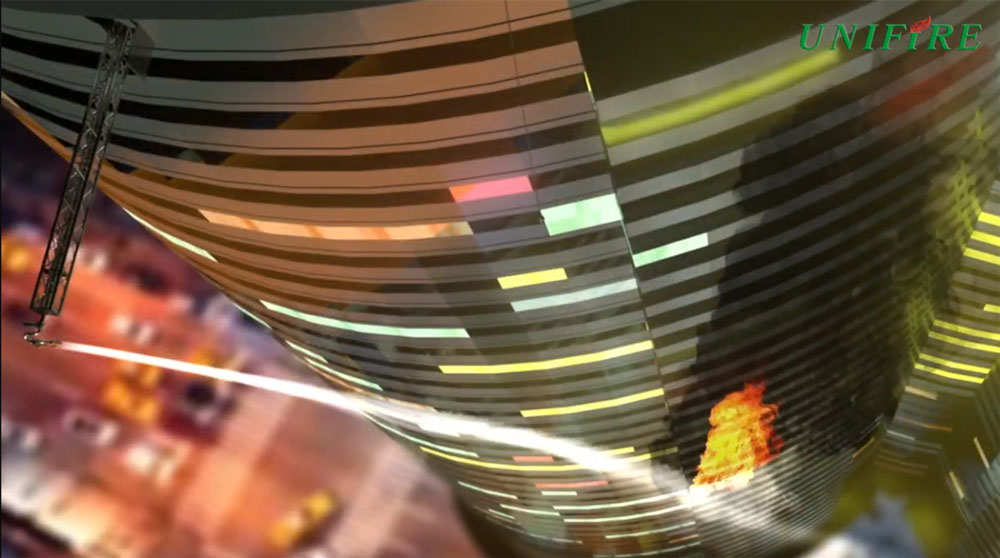Fully Automatic Fire Detection & Suppression for High Rise Building Exteriors with Combustible Cladding
Fully Autonomous Fire Detection & Suppression System for High Rise Building Exteriors Could Prevent Disaster from Combustible Cladding Fires
Unifire AB of Sweden has released a new video of its FlameRanger XT™ fully autonomous fire detection and suppression system designed and tested to protect high rise building exteriors, particularly those with combustible cladding, also known as Aluminum Composite Material (or ACM).
The Problem
Thousands of high-rise building façades around the globe are covered by highly flammable panels, known as cladding or Aluminum Composite Material (or ACM) with combustible cores, such as polyethylene (PE) or polyurethane (PUR). ACM cladding has been used widely because it is relatively inexpensive, light weight, and simple to install. Numerous builders used the material either in violation of regulations prohibiting their use or in compliance with regulations that failed to prohibit their use for a variety of reasons or simple oversight.

The problem is that when ACM cladding catches on fire and reaches the highly flammable PE or PUR core, the result is like putting a match to gasoline. Fire spreads extremely rapidly and burns at high temperatures, spreading from panel to panel at an extraordinary rate. This problem has resulted in scores of infamous fires around the world, such as the Grenfell Tower fire in London on June 14, 2017, which killed 72 residence.
ACM cladding has also been linked to the Lakanal House fire in Camberwell (2009), the Wooshin Golden Suites fire in Busan (2010), the Lacrosse Tower fire in Melbourne (2014), the Marina Torch in Dubai (2015) and the new year’s eve fire at the Address Downtown fire in Dubai (2015-2016), which was witness on live international television, and many, many others.
Although many governments have paid lip service to the problem, and most have banned its use on new buildings, the fact remains that thousands buildings remain cladded in highly combustible ACM panels and the problem is not going away. These buildings are literal time bombs which could erupt in flames at any moment, and regularly do.
One of the major problems in resolving this issue is the prohibitive cost of replacing the combustible cladding and the time and disruption that would be required to do so. Nobody wants to pay for this or accept responsibility. It seems everyone is busy pointing fingers, rather than taking the responsibility head on and take action to mitigate the problem.
Another major problem is that when such a combustible cladding fire breaks out, it spreads so quickly that fire fighters have little chance to combat the fire by the time they arrive. Moreover, fire fighters are unable to reach fires high up on the building’s exterior, as shown here:

A Practical & Proven Solution
To solve this problem in an economical way, Unifire AB of Sweden has developed the FlameRanger XT. FlameRanger XT is a system comprised of fire detectors and robotic nozzles (or water cannons) like those used on firefighting vehicles. The nozzles are designed to be mounted inside of the building and extend outward to fight any fire detected on the building’s façade with a high volume of water.

Each system is able to cover a large area of the building’s exterior, so typically only one system is required to protect an area of approximately 2 500 square meters (a 50 x 50 meter wall section). And, the system can be installed quickly and relatively inexpensively, and often in the service floors without interrupting the activities of the building or its occupants. Moreover, the system can usually tap into the building’s existing water supply.
The FlameRanger XT has been tested and shown to be effective in rapidly detecting and suppressing combustible cladding fires. Video clips from the tests can be seen in the YouTube video referenced above (i.e., https://youtu.be/tnCiLEx3O3w).
The system reacts in seconds, is fully autonomous and requires no human intervention. What’s more, however, is that each robotic nozzle can be remotely controlled at any time by authorized fire fighters or building personnel, from the ground and/or a remote location. This gives the fire brigade full control from the ground, all the way to the top floor of the tallest of buildings.
Unifire has also released a video of the making of the extending boom that moves the robotic nozzle (water cannon) into position for the automatic suppression of fires on building exteriors. The video can be seen by clicking here or on the video link below:
For more information about Unifire’s FlameRanger XT and other advanced fire fighting systems, contact Unifire at Unifire.com.
Article written by Roger Barrett James, Esq.


